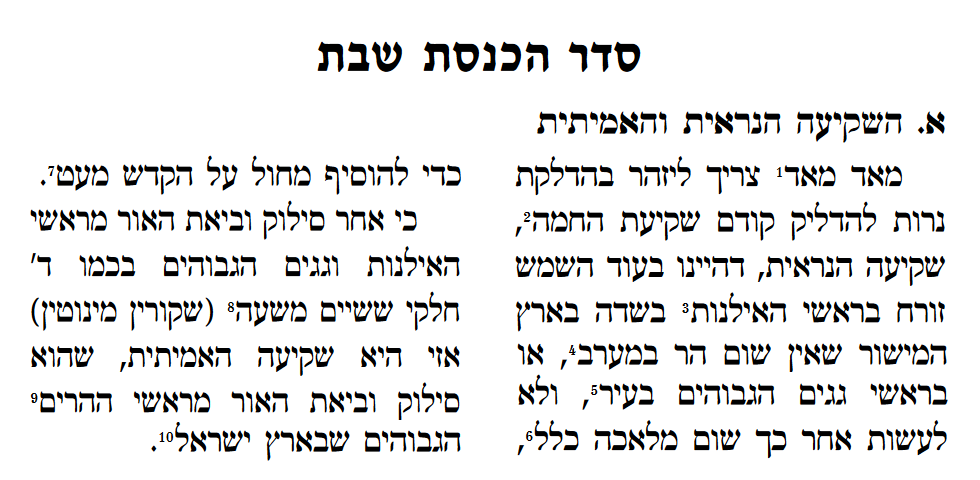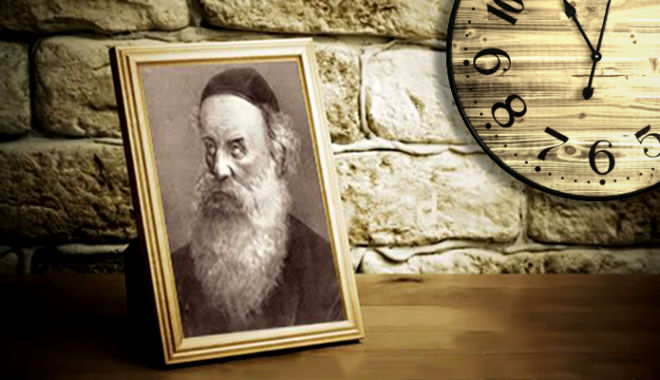
While most calendars list the גר״א Gra and בעל התניא Baal Hatanya zmanim as identical, things are not that simple. Both are based on a day being from sunrise to sunset, but recently some Chabad calendars started using slightly different calculations for the Baal Hatanya’s zmanim. It should be noted that these zmanim are not universally accepted in Chabad (see the Opposing View section below). According to the Baal Hatanya in the סדר הכנסת שבת Seder Hachnasas Shabbos,
מאד מאד צריך ליזהר בהדלקת נרות להדליק קודם שקיעת החמה, שקיעה הניראית, דהיינו בעוד השמש זורח בראשי האילנות בשדה בארץ המישור שאין שום הר במערב, או בראשי גגים הגבוהים בעיר, ולא לעשות אחר כך שום מלאכה כלל, כדי להוסיף מחול על הקודש מעט. כי אחר סילוק וביאת האור מראשי האילנות וגגים הגבוהים בכמו ד׳ חלקי ששיים משעה (שקורין מינוטין) אזי היא שקיעה האמיתית, שהוא סילוק וביאת האור מראשי ההרים הגבוהים שבארץ ישראל.
zmanim are calculated based on a 4 minute delay in shkiah. These 4 minutes are calculated as the sun’s position in degrees before sunrise and after sunset. While Chabad considers netz (also known as hanetz) as standard sunrise and shkiah as standard sunset, this is lechumra, and other zmanim are based on a slightly earlier sunrise and a slightly later sunset.
About 3 1/2 years ago, I posted information on calculating the Baal Hatanya’s Shkiah. That article was focused on a software developer’s perspective and explained how to use the existing API to calculate a fixed clock 4 minute zman that was not natively supported by the KosherJava zmanim library. Recently Yechiel Paricher contributed code to the KosherJava zmanim API/Library that added native support for various Baal Hatanya zmanim. This will enable users of the Zmanim library to easily include Baal Hatanya zmanim in their software.
According to the Baal Hatanya, shkiah amitis (true halachic sunset) is defined as:
כי אחר סילוק וביאת האור מראשי האילנות וגגים הגבוהים בכמו ד׳ חלקי ששיים משעה (שקורין מינוטין) אזי היא שקיעה האמיתית, שהוא סילוק וביאת האור מראשי ההרים הגבוהים שבארץ ישראל.
The time is calculated as the point at which the center of the sun’s disk is 1.583° below the horizon. Chabad applies the same degree based offset to netz amiti (true halachic sunrise). This degree based calculation can be found in Rabbi Shalom DovBer Levine’s commentary on The Baal Hatanya’s Seder Hachnasas Shabbos. From an elevation of 546 meters at the top of Har Hacarmel (based on the Gemara Shabbos 35a), the sun disappears at sunset when it is 1.583° (1° 35′) below the sea level horizon. There are other opinions that are not included in the code (but can easily be calculated using the API). One such example is a very similar (degree-wise) netz amiti from Rabbi Yosef Yitzchok Feigelstock. Rabbi Feigelstock calculates shkiah amitis as the degrees below the horizon 4 minutes after sunset in Yerushalaym (on the equinox). That degree based zman is listed in his letter to Rabbi Levine published in the back of the Seder Hachnasas Shabbos as 1.583°. The 1.583° is a typo (confirmed by Rabbi Feigelstock since it is identical to the 1° 35′ zman) and should be 1.683°. The calculations added to the KosherJava Zmanim library are used by most Chabad calendars that follow the Baal Hatanya’s Zmanim. See About Our Zmanim Calculations @ Chabad.org.
Zmanim based on shaos zmaniyos are based on a day between netz amiti and shkiah amitis calculated as 1.583° below the horizon. The various Baal Hatanya zmanim now part of the zmanim library include:
- Alos 16.9° – based on the sun’s position below the horizon 72 minutes before netz amiti in Yerushayim around the equinox.
- Sunrise or netz amiti – calculated as 1.583° below the horizon. This method is private and is only used as a base for other calculations.
- Sof Zman Shma – calculated as 3 shaos zmaniyos (or a 1/4 of the day) after netz amiti.
- Sof Zman Tfila – calculated as 4 shaos zmaniyos (or a 1/3 of the day) after netz amiti.
- Sof Zman Achilas Chametz – calculated as 4 shaos zmaniyos (or a 1/3 of the day) after netz amiti.
- Sof Zman Biur Chametz – calculated as 5 shaos zmaniyos after netz amiti.
- Mincha Gedola – calculated as 6.5 shaos zmaniyos after netz amiti.
- Mincha Gedola – Greater Than 30 – As above, but with a minimum 30 clock minutes after chatzos.
- Mincha Ketana – calculated as 9.5 shaos zmaniyos after netz amiti.
- Plag Hamincha – calculated as 10.75 shaos zmaniyos after netz amiti.
- Sunset or shkiah amitis – calculated as 1.583° below the horizon. This method is private and is only used as a base for other calculations.
- Tzais – calculated as the time when the sun is 6° below the western horizon. Note that as per Rabbi Yosef Yitzchok Feigelstock, for Motzai Shabbos, Motzai Yom Kippur and Motzai Yom Tov, the 8.5° time should be used. The time between 6° and 8.5° is part of tosfos Shabbos and tosfos Yom Kippur. Other zmanim such as zman krias shema can use the 6° zman. The 8.5° zman has always been part of the API, and sample code for calculating tzais 8.5° can be seen below.
These zmanim (not my implementation) that Chabad.org spent 2 years researching, have a haskama (endorsement) from Chabad Dayanim. Chabad.org zmanim do not provide seconds (appropriate due to expected refraction variances), but with the rounding rules provided by Rabbi Mordechai Sandhaus, the lead developer at Chabad.org, I was able to confirm that the Baal Hatanya zmanim generated by the KosherJava zmanim library match the Chabad.org times.
Please note that there are various Chabad shittos for netz, shkiah and tzais zmanim. The above are the commonly used ones. Other opinions on Baal Hatanya based zmanim that are less commonly used are not included in the API, but given the flexibility of the KosherJava Zmanim API they can easily be calculated.These include:
- Netz Amiti 1.683° as calculated by Rabbi Feigelstock and mentioned above (only used for calculating other zmanim).
- Shkiah Amitis 1.683° as calculated by Rabbi Feigelstock and mentioned above (only used for calculating other zmanim).
- Tzais 5.833° as calculated by Rabbi Shalom DovBer Levine lekula for derabanans.
- Tzais 6.3° as calculated by Rabbi Avrohom Altein, Chabad of Winnipeg, Manitoba, Canada.
- Tzais 6.833° as calculated by Rabbi Shalom DovBer Levine lechumra for deoraysas.
- Tzais 8.5° as commonly used by Chabad lechumra and mentioned above.
Code samples for these zmanim can be seen below.
Opposing Views
The relatively new calculations of zmanim based on netz amiti and shkiah amitis are not universally accepted in Chabad. Rabbi Avrohom Altein, the Rov of Chabad of Winnipeg, Manitoba, mentioned in a correspondence, that it is difficult to accept these new zmanim calculations as is.
The Alter Rebbe only speaks explicitly of shkiya amitis in regards to the beginning of Shabbos. We can draw comparisons to other areas of halacha but those comparisons needs to be carefully evaluated.
I believe that the Alter Rebbe does not calculate shaos zmaniyos based on netz & shkiya amitis, but rather on the standard netz & shkiya. There are several strong proofs to this. In earlier years, all of Chabad calculated shaos zmaniyos for laws of chometz, reading Shema etc., on the basis of standard sunrise and sunset and I believe that’s how the older Colel Chabad Luchos did the calculation. In recent years, this has changed in the Colel Chabad Luchos and chabad.org based on the opinion of Rabbi SDB Levin and Rabbi Feigeslstock — but there are Chabad rabbis that do not agree with their interpretation.
Code Samples
For developers, here is sample code that calculates the new zmanim. This should allow many zmanim apps to add Baal Hatanya zmanim with very little effort.
String locationName = "770 Eastern Parkway";
double latitude = 40.669;
double longitude = -73.943;
double elevation = 30;
TimeZone timeZone = TimeZone.getTimeZone("America/New_York");
GeoLocation location = new GeoLocation(locationName, latitude, longitude, elevation, timeZone);
ComplexZmanimCalendar czc = new ComplexZmanimCalendar(location);
czc.getCalendar().set(1994, Calendar.JUNE, 12);
System.out.println("Alos: " + czc.getAlosBaalHatanya()); //16.9 degrees
System.out.println("Sunrise: " + czc.getSunrise()); //standard sunrise
System.out.println("Sof Zman Shma: " + czc.getSofZmanShmaBaalHatanya());
System.out.println("Sof Zman Tfila: " + czc.getSofZmanTfilaBaalHatanya());
System.out.println("Sof Zman Achilas Chametz: " + czc.getSofZmanAchilasChametzBaalHatanya()); //only use on Erev Pesach
System.out.println("Sof Zman Biur Chametz: " + czc.getSofZmanBiurChametzBaalHatanya()); //only use on Erev Pesach
System.out.println("Mincha Gedola: " + czc.getMinchaGedolaBaalHatanya());
System.out.println("Mincha Gedola Min 30: " + czc.getMinchaGedolaBaalHatanyaGreaterThan30());
System.out.println("Mincha Ketana: " + czc.getMinchaKetanaBaalHatanya());
System.out.println("Plag Hamincha: " + czc.getPlagHaminchaBaalHatanya());
System.out.println("Sunset: " + czc.getSunset()); //standard sunset
System.out.println("Tzais Baal Hatanya: " + czc.getTzaisBaalHatanya()); //6° degrees
System.out.println("Tzais 8.5°: " + czc.getTzaisGeonim8Point5Degrees()); //8.5° degrees lechumra commonly used by Chabad
System.out.println("Shaah Zmanis Baal Hatanya: " + czc.getShaahZmanisBaalHatanya());
Calculating other Baal Hatanya based zmanim not included in the library are very simple. Here are a few examples
System.out.println("Netz Amiti 1.683°: " + czc.getSunriseOffsetByDegrees(90 + 1.683)); //Rabbi Feigelstock netz amiti (only used for calculating other zmanim)
System.out.println("Shkiah Amitis 1.683°: " + czc.getSunsetOffsetByDegrees(90 + 1.683)); //Rabbi Feigelstock shkiah amitis (only used for calculating other zmanim)
System.out.println("Tzais 5.833°: " + czc.getSunsetOffsetByDegrees(90 + 5.833)); //Rabbi Levine lekula for derabanans
System.out.println("Tzais 6.3°: " + czc.getSunsetOffsetByDegrees(90 + 6.3)); //Rabbi Avrohom Altein
System.out.println("Tzais 6.833°: " + czc.getSunsetOffsetByDegrees(90 + 6.833)); //Rabbi Levine lechumra for deoraysas
I would like to thank Rabbi Yosef Yitzchok Feigelstock, the Rov of Chabad in Buenos Aires, Rabbi Avrohom Altein, the Rov of Chabad in Winnipeg and Rabbi Mordechai Sandhaus, the lead developer at Chabad.org for reviewing this post.
